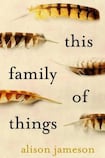
Put any family under a microscope and watch as the Anna Karenina principle (Happy families are all alike; every unhappy family is unhappy in its own way) comes into its own.
Tolstoy's aphorism is particularly accurate when applied to This Family of Things, a beautifully intricate study which lays bare the twin pulls of joy and despair that are the metronome beat of life. The relationships between the Keegan siblings ring pin-sharp: even in a conversation of no real significance innocuous words can "carry a small barb of tension".
Retired teacher Margaret, a woman who keeps the memory of being jilted 30 years earlier alive like a rent-free lodger inside her, shares a comfortable home in rural Wicklow with her sister Olive.
Nearby, their younger half-deaf brother Bird (who sums up the Keegans as “an oddball farmer and his two spinster sisters”) lives alone in the decaying family farm, a place of dark corners and damp, empty beds. His sisters are involved in the local community, whereas he is a man who “did not share himself with anyone”.
In their local town of Tullyvin, 20-year-old Midge Connors is trapped in a rotten home at the mercy of her abusive father. Her unravelled mother is unable to protect either Midge or herself from Charlie, an alcoholic who had shown his daughter “no love at all and instead spent his time trying to plough through her”.
On the night Charlie pushes Midge out of a moving car, Bird finds her hiding in his yard: “Lifting her was like retrieving a ball of newspaper from out of the grass or an empty crisp bag that someone had flung over the ditch. She seemed to lack the bones and meat and muscle of real people.”
To the scorn of his neighbours and sisters, Bird takes her in, an uncharacteristic act that changes everything. But Midge had “survived a kind of war” before she met him and the trauma of her childhood is not easily recovered from. With the arrival of Midge, the Keegans’ inner and outer lives are exposed and explored, particularly those of Bird and Margaret, who are the book-ends of the family. Olive’s heart is examined the least: recent ill-health has focused her attitude to life.
From the outset, Midge is both real and unreal to Bird; a folktale-like air hangs over their relationship as though she is a homesick mermaid stolen from the lake nearby. Water exerts a powerful influence in the book, both as liberator – people strip off and swim – and later on, as an oppressor.
At one point Margaret reflects that she “could see now she had spent her life like a pickle in a jar of salt water”. The writing becomes more direct as the action becomes more complex: a scene of complete horror is described, with terrifying simplicity, as “he got at them”.
The life of a small community, one dependent on itself for news, is neatly rendered when Bird becomes a subject of gossip and Jameson acerbically notes, “The people around Tullyvin were spending a great deal of time talking about Bird Keegan. He was popular enough in his own way but they were often annoyed by his lack of interest in them.”
There is a curiously Brigadoonish air about Tullyvin; in places the story could have been set in an older, earlier Ireland. Sporadic mentions of the internet and mobile phones come as occasional and sometimes necessary reminders that we are in the present rather than an isolated, tightly-tied past.
This quality is highlighted by a vagueness about dates, such as when Bird describes an event as happening 20 years earlier, yet we later discover he was out by more than a decade. When the story shifts to Oregon that sense completely dissipates and the focus becomes clearer, as though the sun has burnt off an early morning mist.
There is a point early on where the shock-waves caused by Midge’s entry in their lives have settled into calm ripples, and the Keegans’ metronome appears to be joyously stuck at happy-ever-after.
A less gifted writer might have left the story there, but of course the end is never the end, and Jameson keeps the pendulum moving until we reach a determinedly unsentimental – and much more satisfying for it – place. As with life, the beat continues.
Henrietta McKervey is the author of two novels, ‘What Becomes Of Us’ (2015) and ‘The Heart of Everything’ (2016), both published by Hachette. ‘The Heart of Everything’ was an Irish Times Book Club choice.











